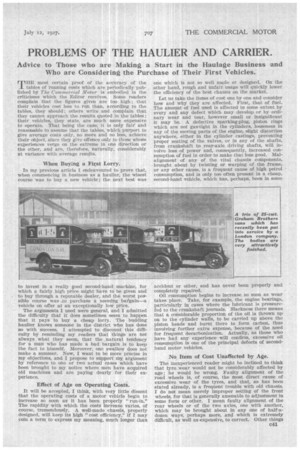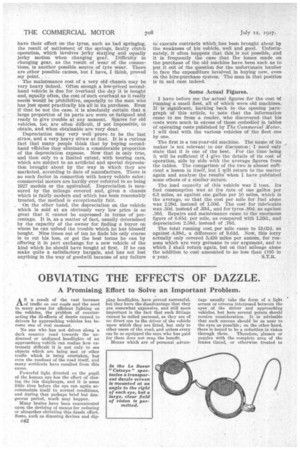PROBLEMS OF THE HAULIER AND CARRIER.
Page 63

Page 64

If you've noticed an error in this article please click here to report it so we can fix it.
Advice to Those who are Making a Start in the Haulage Business and Who are Considering the Purchase of Their First Vehicles.
THE most certain proof of the accuracy of the tables of running costs which are periodically published by The Commercial Motor is embodied in the criticisms which the Editor receives. Some readers complain that the figures given are too high ; that their vehicles cost less to run than, according to the tables, they should; others write and complain that they cannot approach the results quoted in the tables; their vehicles, they state, are much more expensive to operate. That being the case, it is only fah' and reasonable, to assume that the tables, which purport to give average costs only, no more and no less, achieve their object: since they give offence only to those whose experiences verge on the extreme in one direction or the other, and are, therefore, naturally, considerably at variance with average results.
When Buying a Fist Lorry.
In my previous article I endeavoured to prove that, when commencing in business as a haulier, the wisest course was to buy a new vehicle; the next best was
to invest in a really good second-hand machine, for which a fairly high price might have to be given and to buy through a reputable dealer, and the worst possible course was .to purchase a seeming bafgain—a vehicle on offer at an exceptionally low price.
The arguments I used were general, and I admitted the difficulty that it does sometimes seem to happen that it pays to buy a cheap lorry. The budding haulier knows someone in the district who has done so with success. I attempted to discount this difficulty by reminding my readers that things are not always what they seem, that the natural tendency for a man who has made a bad bargain is to keep the fact to himself. Moreover, one swallow does not make a summer. Now, I want to be more precise in my objections, and I propose to support my argument by reference to one or two actual cases which have been brought to my notice where men have acquired old machines and are paying dearly for their experience.
Effect of Age on Operating Costs.
It will be accepted, I think, with very little dissent that the operating costs of a motor vehicle begin to increase so soon as it has been properly "run-in." The rapidity with which the costs increase varies, of course, tremendously. A well-made chassis, properly designed, will keep its high 'cost efficiency," if I may coin a term to express my meaning, much longer than
one which is not so well made or designed. On the other hand, rough and unfair usage will quickly lower the efficiency of the best chassis on the market.
Let us take the items of cost one by one and consider how and why they are affected. First, that of fuel. The amount of fuel used is affected to some extent by every and any defect which may develop or by ordinary wear and tear, however small or insignificant it may be. A defective sparking-plug, piston rings which are not gas-tight in the cylinders, looseness in any or the moving parts of the engine, slight distortion anywhere, either in the cylinder castings, preventing proper seating of the valves, or in any of the shafts, from crankshaft to rear-axle driving shafts, will involve loss of power and, consequently, increased consumption of fuel in order to make that loss good. Malalignment of any of the vital chassis components, brought about by twisting or warping of the frame, or any other cause, is a frequent cause of high petrol consumption, and is only too often present in a cheap, second-hand vehicle, which has, perhaps, been in some accident or other, and has never been properly and completely repaired.
Oil consumption begins to increase so soon as wear takes place. Take, for example, the engine bearings, particularly in cases where the lubricant is pressurefed to the crankshaft journals. Slackness there means that a considerable proportion of the oil is thrown upon to the cylinder walls, to be carried up above the piston heads and burnt there to form carbon, thus involving further extra expense, because of the need for frequent decarbonization. Actually, as those who have had any experience will confirm, excessive oil consumption is one of the principal defects of secondhand motor vehicles.
No Item of Cost Unaffected by Age.
The inexperienced reader might be inclined to think that tyre wear would not be considerably affected by age; he would be wrong. Faulty alignment of the road wheels is, of course, the most direct cause of excessive wear of the tyres, and that, as has been stated already, is a frequent trouble with old chassis.
do not mean merely improper setting of the front wheels, for that is generally amenable to adjustment in some form or other. I mean faulty alignment of the rear wheels or of the two axles, one with another, which may be brought about in any one of half -adozen• ways, perhaps more, and which is extremely difficult, as well as .expensive, to correct. Other things
have their effect on the tyres, such as bad springing, the result of settlement of the springs, faulty clutch operation, which involves jerky starting and equally jerky motion when changing gear. Difficulty in changing gear, as the result of wear of the connections, is another possible source of tyre wear. There are other possible causes, but I have, I think, proved my point.
The maintenance cost of a very old chassis may be very heavy indeed. Often enough a low-priced secondhand vehicle is due for overhaul the day it is bought and, equally often, the cost of such overhaul as it really needs would be prohibitive, especially to the man who has just spent practically his all in its purchase. Even if that be not the case, it is absolutely certain that a large proportion of its parts are worn or fatigued and ready to give trouble at any moment. Spares for old vehicles, too, are often difficult, if not impossible, to obtain, and when obtainable are very dear.
Depreciation may very well prove to be the hist straw, and a very heavy straw at that. It is a curious fact that many people think that by buying secondhand valicles they eliminate a considerable proportion • of the depreciation expense. Now that is only true, and then only to a limited extent, with touring cars, which are subject to an artificial and special depreciation brought about by the way in which they are marketed, according to date of manufacture. There is no such factor in connection with heavy vehicle sales; commercial motors are hardly ever referred to as being 1927 models or the equivalent. Depreciation is measured by the mileage covered and, given a chassis which is fairly modern and which has been reasonably treated, the method is exceptionally fair.
On the other hand, the depreciation on the vehicle which is sold at an obviously very low price is so great that it cannot be expressed in terms of percentage. It is, as a matter of fact, usually determined by the capacity of the owner for finding a buyer on whom he can unload the trouble which he has himself bought. Nine times out of ten he finds his only course is to cut his loss, or get the best terms he can by offering it in part exchange for a new vehicle of the kind which he should have bought at first. If he can make quite a satisfactory bargain, and has not lost anything in the way of goodwill because of any failure to execute contracts which has been brought about by the weakness of his vehicle, well and good. Unfortunately, it often happens that this is not possible, and it is frequently the case that the losses made on the purchase of the old machine have been such as to put it out of the question for the unfortunate haulier to face the expenditure involved, in buying new, even on the hire-purchase system. The man in that position is in sad case indeed.
Some Actual Figures.
I have before me the actual figures for the cost of running a small fleet, all of which were old machines. It is significant, harking back to the opening paragraph of this article, to note that the information came to me from a reader, who discovered that his costs were much in excess of those embodied in tables of operating costs published by The Commerial Motor. I will deal with the various vehicles of the fleet one by. one.
The first is a ten-year-old machine. The name of its maker is not relevant to our discussion; I need only state that it is one of the best. For the time being it will be sufficient if I give the details of its cost of operation, side by side with the average figures from the tables. The comnarison of the two is almost sufficient a lesson in itself, but I will return to the matter again and analyse the results when I have published some others of a similar nature.
The load capacity of this vehicle was 2 tons. Its fuel consumption was at the rate of one gallon per 6.3 miles, as against one gallon per 10 miles, which is the average, so that the cost per mile for fuel alone was 2.29d. instead of 1.50d. The cost for lubricahts was .50d. instead of .33d., and for tyres .80d. as against .56d. Repairs and maintenance came to the enormous figure of 6.8541. per mile, as compared with 1.23d., and depreciation 2.58d. instead of .76d.
The total running cost, per mile came to I3.02d. as against .4.381, a difference of 8.64d. Now, this lorry actually only covered 5,420 miles per annum, for reasons which are very germane to our argument, and to which I shall return again, but on that mileage alone the addition to cost amounted to no less than £195 in a year. S.T.R.












































































































